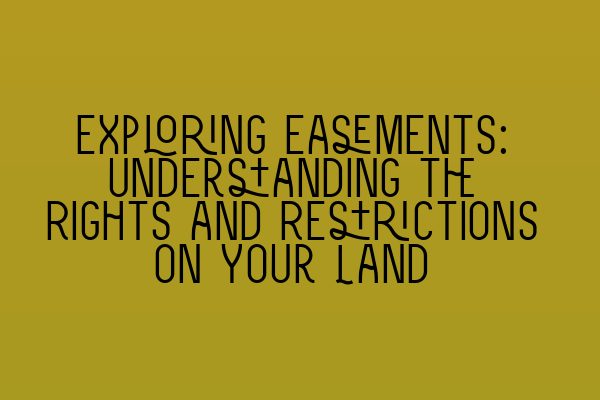Exploring Easements: Understanding the Rights and Restrictions on Your Land
When it comes to property ownership, it’s essential to have a clear understanding of the rights and restrictions that may arise on your land. One such concept that plays a significant role in land law is an easement. Understanding what easements are and how they can affect your property is crucial for all property owners, landlords, and tenants.
In this article, we will dive deep into the world of easements, exploring their definition, types, creation, and termination. So, let’s get started!
What is an Easement?
An easement is a legal right that allows a person to use or access another person’s land, typically for a specific purpose. It grants the holder of the easement a non-possessory interest in the land, meaning they do not gain ownership of the property but have certain rights over it.
Easements are often created to provide necessary access to landlocked properties or to allow essential services to pass through one property to reach another. They can also be created for the benefit of the public, such as public footpaths or utility lines.
Types of Easements
There are several types of easements that can be created, each serving a specific purpose. Let’s take a closer look at the main types:
1. Appurtenant Easements
An appurtenant easement occurs when the rights and benefits of the easement are attached to the ownership of a particular piece of land. The easement not only benefits the current owner but also passes on to any subsequent owners of the property. This type of easement is commonly seen in situations where a property relies on a shared driveway or a right of way to access a public road.
2. Easements in Gross
An easement in gross is an easement that benefits a specific individual or entity rather than being attached to a particular piece of land. Unlike appurtenant easements, easements in gross do not pass on to subsequent property owners. Examples of easements in gross can include utility lines passing through a property or a right of way granted to a utility company.
3. Prescriptive Easements
A prescriptive easement is an easement that is acquired through regular and continuous use of another person’s land without permission. To establish a prescriptive easement, the use of the land must be open, notorious, hostile, exclusive, and continuous for a specified period of time. The requirements for creating a prescriptive easement vary by jurisdiction, so it’s crucial to consult with a property law expert to understand the specific rules in your area.
4. Easements by Necessity
An easement by necessity is created when a parcel of land becomes landlocked, meaning it has no direct access to a public road or another means of access. In such cases, the law recognizes the necessity for an easement to ensure the landlocked property’s reasonable use and enjoyment. Easements by necessity are typically granted by courts and are a vital legal tool for resolving landlocked property disputes.
Creation and Termination of Easements
Easements can be created in various ways, including:
- Express grant: A landowner can grant an easement to another party through a written agreement or a deed.
- Implied grant: Easements can be implied based on the circumstances surrounding the land ownership or use.
- By necessity: As mentioned earlier, easements by necessity can be created when a property becomes landlocked.
- Prescription: When a person openly and continuously uses another person’s land without permission for a specified period, a prescriptive easement can be acquired.
On the other hand, easements can be terminated in several ways, including:
- Express release: The owner of the easement can release their rights, terminating the easement.
- Mutual agreement: Both parties involved in the easement can agree to terminate it.
- Expiration: Easements can have expiration dates specified in the agreement.
- Abandonment: If the easement holder stops using the easement and intends to abandon it, the easement may be terminated.
Conclusion
Easements are a critical aspect of property law, determining the rights and restrictions on land. Whether you are a property owner, landlord, or tenant, understanding easements and their implications is essential to protect your interests.
By familiarizing yourself with the different types of easements, how they are created and terminated, you can navigate property ownership with confidence.
If you have any questions about easements or require legal assistance in dealing with an easement issue, don’t hesitate to reach out to SQE Property Law & Land Law. Our team of expert solicitors is here to provide you with the guidance you need.
Related Articles:
